Ka‘ena Point Ecosystem Restoration Project
Posted on Oct 25, 2013
Ka‘ena Point is located at the very northwest tip of the island of O‘ahu. It is about 10 miles west of Waialua on the North Shore and 10 miles north of Wai‘anae on the leeward coast. Within this area is the 59-acre Ka‘ena Point Natural Area Reserve, owned and managed by the Hawai‘i Department of Land and Natural Resources.
A cultural resource
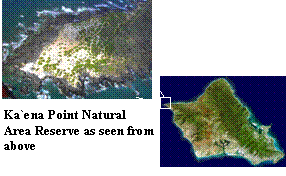 People have been a part of Ka‘ena Point for generations. Many trace their ancestors to this special place. Within the reserve is leina a ka ‘uhane (Spirit Leap), which is considered to be a wahi pana, a celebrated legendary place. Early Hawaiians used Ka‘ena Point for fishing and feather collecting. Today, people of various cultures visit Ka‘ena Point for fishing, hiking, bicycling, and other recreational and educational activities.
People have been a part of Ka‘ena Point for generations. Many trace their ancestors to this special place. Within the reserve is leina a ka ‘uhane (Spirit Leap), which is considered to be a wahi pana, a celebrated legendary place. Early Hawaiians used Ka‘ena Point for fishing and feather collecting. Today, people of various cultures visit Ka‘ena Point for fishing, hiking, bicycling, and other recreational and educational activities.
Current public use
Vehicle access was eliminated in the Natural Area Reserve in the late 1980s to allow wildlife to recover, and today entry in only by foot or on mountain bikes. On the northern end, the reserve begins approximately two miles past the end of the paved road and extends beyond the boulder barricade and around the Point towards Wai‘anae. The reserve is open year round to all recreational users, including fishers, who enjoy fishing from the shore of the reserve.
The wildlife of Ka‘ena
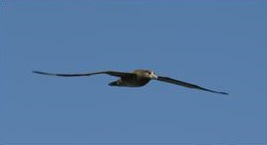 Ka‘ena Point is an excellent example of the type of ecosystem that can be found in Northwestern Hawaiian Islands. The difference is that anyone on O‘ahu can drive to Ka‘ena Point to see this spectacular display of plants and animals.
Ka‘ena Point is an excellent example of the type of ecosystem that can be found in Northwestern Hawaiian Islands. The difference is that anyone on O‘ahu can drive to Ka‘ena Point to see this spectacular display of plants and animals.
- It is home to nesting seabirds, monk seals, and other native coastal species.
- One of the largest seabird colonies in the eight main Hawaiian Islands is found here. Recent surveys have estimated approximately 2,000 seabirds use Ka‘ena Point as their breeding grounds, and many more than that use the area as a place of refuge.
- With adequate protection, it has the potential to become a safe haven for many more species of Hawai‘i’s seabirds, plants, and insects that cannot survive elsewhere.
If alien species are removed, seabirds prospecting for new nesting areas will re-colonize Ka‘ena Point. Some plants will return on their own and others can be re-introduced. Ka‘ena Point Natural Area Reserve has the potential to serve as a safe haven for many years. It is one more step towards preserving Hawai‘i’s past for the children and future generations.
What is threatening the wildlife at Ka‘ena?
Rats and Mice: Observations from Hawai‘i and around the world have shown that rats will eat seabird eggs and chicks, and even attack adult birds. Scientists estimate that rats have caused 40-60% of all bird and reptile extinctions on islands worldwide. Rats and mice also eat native plants and seeds.
Mongoose, Cats, and Dogs: At Ka‘ena Point in 2006, 15% of wedge-tailed shearwater chicks were killed by these predators. In 2007, 13% of Laysan albatross chicks were also killed. These birds nest on the ground and are extremely vulnerable, especially if they cannot yet fly.
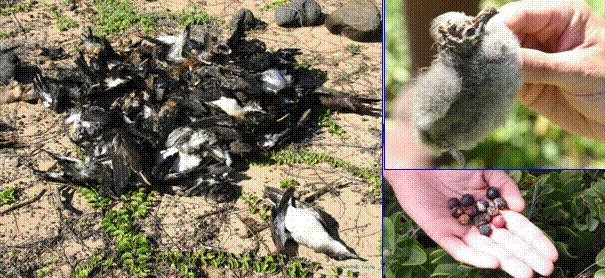
Clockwise from Left: Over 100 wedge-tailed shearwaters killed by dogs and cats in 2006 at Ka‘ena Point; shearwater chick killed by rats; sandalwood seeds eaten by rodents
Despite intensive efforts to control predators such as rats, mice, mongoose and others, they continue to threaten nesting seabird populations. Without our help, seabird and native plant communities at Ka‘ena Point will continue to be attacked by these alien predators.
Plants and Animals of Ka‘ena
Seabirds have been found at Ka‘ena Point for thousands of years and were once an important source of food for early Hawaiians inhabiting the area as evidenced by bird bones found in ancient campfires. While the birds abandoned nesting at Ka‘ena for a time, with recent protection, they are now returning.
 Nesting seabird species:
Nesting seabird species:
- Laysan Albatross (Moli)
- Wedge-tailed Shearwater (‘Ua ‘u kani)
- White-tailed Tropicbird (Koa‘e ‘ula)
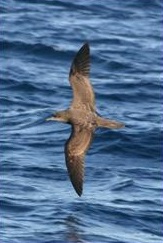 Other native birds observed:
Other native birds observed:
- Black-footed Albatross
- Great Frigatebird (‘Iwa)
- Red-footed, Brown and Masked Boobies (‘A)
- Red-tailed Tropicbird (Koa ‘e‘ula)
- Grey-backed (Pakalakala), Sooty (‘Ewa ‘ewa) and White Terns (Manu-o-kū)
- Hawaiian Short-eared Owl (Pueo)- for more information on Pueo, please click here
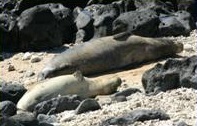 Migratory shorebirds:
Migratory shorebirds:
- Wandering tattler (‘ulili)
- Ruddy turnstone (‘akekeke)
- Pacific golden plover (kolea)
Other animals:
- Hawaiian monk seal (‘ilioholokiauaua)
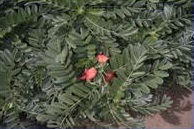 Native plants:
Native plants:
- Many coastal plants such as naupaka, ‘ilima, and naio
- Eleven federally endangered species such as ‘ohai and ‘akoko (a species found only at Ka‘ena Point)
Is there a solution to predation?
Ecosystem restoration through fencing: The goal of ecosystem restoration is to provide a safe place for Hawai‘i’s native seabirds, plants, and insects by removing destructive alien species and allowing the native species to rebound. New technology in pest-proof fencing holds promise. A pest proof fence could effectively keep out all kinds of mammalian pests- from large animals such as pigs and dogs, to small animals such as mongoose and rats.
A fence with a combination of features– built approximately 6.5 feet high with a rolled hood at the top, fine mesh between the fence posts, and a skirt buried underground — prevents animals from jumping, climbing, squeezing through or digging their way around the fence and into the protected area. This type of pest proof fence was developed in New Zealand and has been used very successfully.

A 40 km long pest proof fence in New Zealand
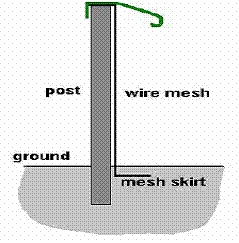
Pest proof fence diagram
If this method were used, there would be two steps: first fence construction followed by predator removal. Compared to the current cost of protecting native seabirds and plants from alien species at Ka‘ena Point, a fence would start to save money by eliminating the need to constantly remove alien species.
Larger predators, such as cats and mongoose, will be removed by trapping. Rodents, such as mice and rats, will be removed with a combination of trapping and the use of rodenticide. Diphacinone is a type of rodenticide that is proven safe to use in public areas and around bird species. It was recently trialed on islets near Kaua‘i and Moloka‘i will likely be used at Ka‘ena. The effects of diphacinone on non-target species, such as birds and marine organisms, have been studied extensively and found to be minimal or non-existent. For example, a Pueo (Hawaiian Owl) would have to eat 81 pounds (xx times its body weight) of dead rats laced with rodenticide before it became ill. For more information on diphacinone please click here.
If constructed, this will be the first pest proof fence not only in Hawai‘i, but in the United States. It would be a great example of the people of Hawai‘i showing leadership in protecting and restoring their unique natural resources.
How could the project affect me?
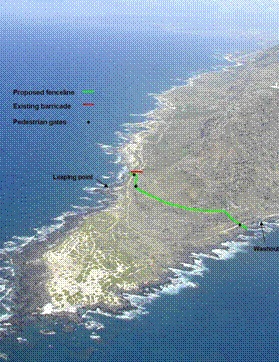
Aerial view of proposed fence
Access: People would still be allowed to visit both during and after construction. There would be unlocked doors that would allow people on foot and on mountain bikes to enter the reserve at the existing entrances on both the North shore and West side.
Views: The fence would run along the base of the Wai‘anae Mountains following the existing upper road bed. It would come down to the high tide line at either end where the existing entrances to the natural area reserve are, but will not fully encircle the reserve. The fence would be designated to blend into the hillside and will be less visible than a traditional chain link fence.
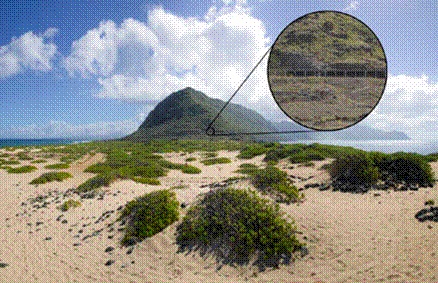
What a pest proof fence may look like from the point

What a pest proof fence may look like from the Waianae entrance to the reserve
Community Involvement
The Ka‘ena Point Ecosystem Restoration Project outreach team have been very active in the communities surrounding Ka‘ena Point (both the Mokulē‘ia and Wai‘anae sides), and have consulted with hundreds of individuals and community organizations to ensure that everyone is aware of the project and given the opportunity to provide feedback. The vast majority of people that have been contacted support this project and are interested in ensuring that Ka‘ena Point is protected.
The outreach team have given presentations to North Shore Neighborhood Board, the Wai‘anae Neighborhood Board, Mokulē‘ia Community Association, Wai‘anae Hawaiian Civic Club, Earthjustice Legal Defense Fund, Sierra Club, Hawaiian Trail and Mountain Club, Ahahui Mālama I ka Lōkahi, fishers meeting in Wai‘anae, 4×4 clubs, and many others.
The outreach team also conducted user surveys at Ka‘ena Point on three weekends during the fall of 2007, to get input from actual users of Ka‘ena Point about why they visit Ka‘ena and what they think about the proposed fencing. The same survey was administered at the “Hawai‘i Fishing and Seafood Festival” held at Pier 38 in October 2007. The outreach team prepared a brochure and poster display for the Hawai‘i Conservation Conference and other similar events.
Outreach meetings continue with the Office of Hawaiian Affairs’ Native Hawaiian Historical Properties Council, Friends of Honouliuli, Hawai‘i Audubon Society, native Hawaiian elders from the North Shore and Wai‘anae, schools in the region, and the recently formed Friends of Ka‘ena group.
The future of Ka‘ena Point?
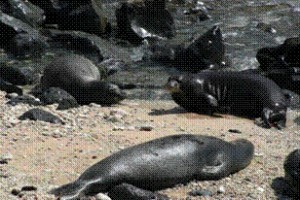 By removing alien species from Ka‘ena Point, two main things will happen:
By removing alien species from Ka‘ena Point, two main things will happen:
- existing populations of seabirds and native plants will increase
- species that would use the Ka‘ena Point ecosystem, but were unable to when predators were present, will return or will be transplanted here
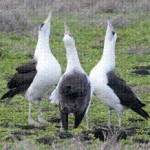 As a result, larger populations and more types of plants and wildlife will be found within the reserve. By removing alien species from Ka‘ena Point we have the opportunity to restore this rare ecosystem to its natural state and preserve a precious piece of Hawai‘i for future generations.
As a result, larger populations and more types of plants and wildlife will be found within the reserve. By removing alien species from Ka‘ena Point we have the opportunity to restore this rare ecosystem to its natural state and preserve a precious piece of Hawai‘i for future generations.
How can I help?
 There are a number of ways you can help:
There are a number of ways you can help:
- keep pets at home when visiting the reserve
- stay on the trail
- pack all trash out
- respect cultural sites
- volunteer on service visits for trail maintenance and weed pulling
- give us your input and ideas about a predator-proof fence
For more information on this project, please email us.
or write to:
DLNR Natural Area Reserve System
1151 Punchbowl Street, Rm. 325
Honolulu, HI 96813
Documents, Downloads & Links
- Printable brochure for Ecosystem Restoration project
- Printable brochure for Ka‘ena Point Natural Area Reserve
- Draft Environmental Assessment [12MB]
- Pueo Fact Sheet
- Predator Removal Information
- Project FAQ
- KHNL News 8 Story
- KHON 2 news story
- Honolulu Advertiser article
- Honolulu Star-Bulletin article
Ka‘ena Point: Restoring a Sanctuary
Photo Credits: Lindsay Young, Eric VanderWerf, Xcluder Pest Proof Fencing company, and Google earth
Site Last Updated 02/2009